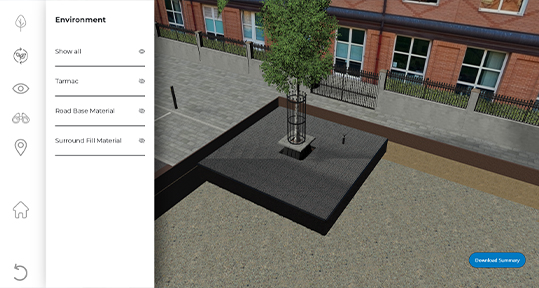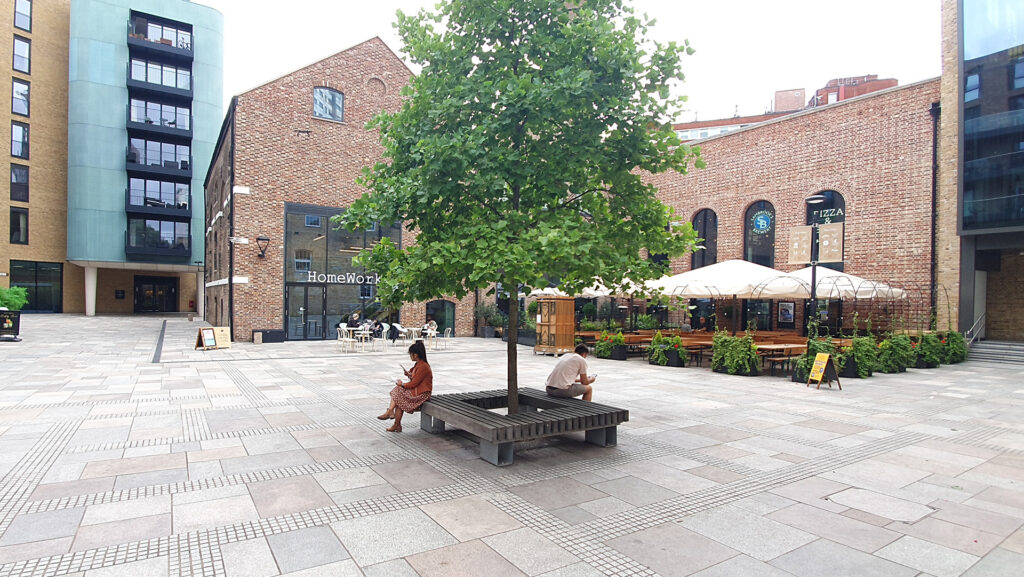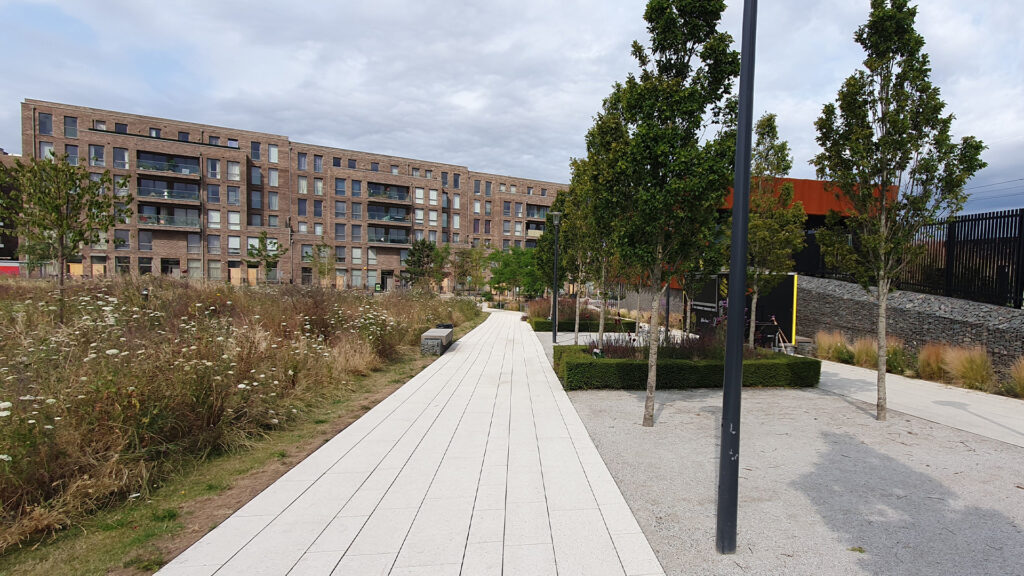‘5 Broadgate is a catalyst for a much wider regeneration that is re-energising a development stuck in aspic since the 1980s.’ Nigel Webb, Development director, British Land.
‘5 Broadgate is a catalyst for a much wider regeneration that is re-energising a development stuck in aspic since the 1980s.’ Nigel Webb, Development director, British Land.
This particular north east corner of the City of London must be one of the most frequently changing urban ‘landscapes’ anywhere. The original idea was that Broad Street would be the starting point for Midlands-bound goods from London’s docks, but even before the building was finished, the developers realised that passenger traffic would prove more lucrative. Opened in 1865 as the terminus of the North London Line, Broad Street quickly became the third busiest station in London. In the early 1900s, more than one steam hauled train a minute arrived at or left the station during the morning rush hour, with over 27 million passengers using the terminus in 1902 alone.
Alternative bus and tube transport prematurely eroded the popularity of the North London Line and, by 1985, Broad Street was a mortally reduced shadow of its former greatness, with only about 300 commuters arriving each day.
The development of the32 acre Broadgate Development completely erased all traces of railway origin to give a timeless, integrated, stable and popular focal point for major corporates and their workers. When built it was certainly a catalyst for the commercialising of the whole Bishopsgate neighbourhood.
Project
Location
Contractor
Landscape Architect
‘5 Broadgate is a catalyst for a much wider regeneration that is re-energising a development stuck in aspic since the 1980s.’ Nigel Webb, Development director, British Land.
‘5 Broadgate is a catalyst for a much wider regeneration that is re-energising a development stuck in aspic since the 1980s.’ Nigel Webb, Development director, British Land.
This particular north east corner of the City of London must be one of the most frequently changing urban ‘landscapes’ anywhere. The original idea was that Broad Street would be the starting point for Midlands-bound goods from London’s docks, but even before the building was finished, the developers realised that passenger traffic would prove more lucrative. Opened in 1865 as the terminus of the North London Line, Broad Street quickly became the third busiest station in London. In the early 1900s, more than one steam hauled train a minute arrived at or left the station during the morning rush hour, with over 27 million passengers using the terminus in 1902 alone.
Alternative bus and tube transport prematurely eroded the popularity of the North London Line and, by 1985, Broad Street was a mortally reduced shadow of its former greatness, with only about 300 commuters arriving each day.
The development of the32 acre Broadgate Development completely erased all traces of railway origin to give a timeless, integrated, stable and popular focal point for major corporates and their workers. When built it was certainly a catalyst for the commercialising of the whole Bishopsgate neighbourhood.
Project
Location
Contractor
Landscape Architect
Project
Location
Contractor
Landscape Architect
Controversially, however, by 2011, numbers 2 and 4 Broadgate were themselves, after prolonged objections, demolished to make way for the totally contrasting style of 5 Broadgate. Objection was taken to the breaking in upon the integrity of the Broadgate Circle architecture but even more to the startling and innovative character of the huge stainless steel clad replacement.
Christopher Costelloe, the director of the Victorian Society, expressed the objections to the new building. “It is unsustainable development, parasitic on the more humanely designed areas around it, which its creation has eroded. 5 Broadgate is an expensively crafted carbuncle.” Whatever your tastes, however, the original Broadgate despite its relative youth needed rejuvenating.
Sustainability is a life-changing and enhancing catalyst, with so many aspects now regarded as mandatory. It demands totally different design parameters. The short life of the preceding buildings is proof of the speed with which sustainability has attained primacy in urban regeneration thinking.
Although aesthetically controversial, impressive sustainability gains and environmental enhancements together with significantly increased retail outlets and eateries have given a major boost to the vibrant lifestyle of this part of the City of London.
Controversially, however, by 2011, numbers 2 and 4 Broadgate were themselves, after prolonged objections, demolished to make way for the totally contrasting style of 5 Broadgate. Objection was taken to the breaking in upon the integrity of the Broadgate Circle architecture but even more to the startling and innovative character of the huge stainless steel clad replacement.
Christopher Costelloe, the director of the Victorian Society, expressed the objections to the new building. “It is unsustainable development, parasitic on the more humanely designed areas around it, which its creation has eroded. 5 Broadgate is an expensively crafted carbuncle.” Whatever your tastes, however, the original Broadgate despite its relative youth needed rejuvenating.
Sustainability is a life-changing and enhancing catalyst, with so many aspects now regarded as mandatory. It demands totally different design parameters. The short life of the preceding buildings is proof of the speed with which sustainability has attained primacy in urban regeneration thinking.
Although aesthetically controversial, impressive sustainability gains and environmental enhancements together with significantly increased retail outlets and eateries have given a major boost to the vibrant lifestyle of this part of the City of London.
Incorporating aspects of the Broadgate masterplan and reinvigorating open spaces and pedestrian routes, the innovative design by Ken Shuttleworth of Make Architects came from the idea of a perfectly cast engine of finance. The windows, courtyards and terraces skilfully carved out of the machined block help to make 5 Broadgate one of the world’s greenest buildings, with 65% lower carbon emissions than the previous two buildings on the site and a BREEAM ‘Excellent’ rating.
Much of the sustainability gain is out of sight with more than a thousand square metres of thermal and photovoltaic solar panels on the roof. A similar area of green roofs and mid-level terrace ‘courtyards’ supplement the refurbished public realm landscaping which includes a magnificent specimen Quercus palustris, a Pin Oak distinguished by its spectacular red autumn foliage. 15m tall it has a girth of 1.2m and a rootball 2.5m across.
GreenBlue Urban supplied the horticultural and engineering infrastructure to ensure that this tree enjoys the best possible root environment consistent with both sustainable soil conditions and the capacity to achieve its majestic potential in years to come. The company deployed a full range of their products, specified by the distinguished landscape architects Hyland Edgar Driver. Included were 880 StrataCells, 150 linear metres of ReRoot barrier plus Loadbearing Geonet and Silver Grey Arboresin which were installed with the help of Frosts Landscape Construction.
Ulrich Koerner, CEO, UBS Group Europe, Middle East and Africa commented “The development of such an impressive new office signals the continuation of UBS’s long and successful relationship with the UK, the City of London and Broadgate.”
Incorporating aspects of the Broadgate masterplan and reinvigorating open spaces and pedestrian routes, the innovative design by Ken Shuttleworth of Make Architects came from the idea of a perfectly cast engine of finance. The windows, courtyards and terraces skilfully carved out of the machined block help to make 5 Broadgate one of the world’s greenest buildings, with 65% lower carbon emissions than the previous two buildings on the site and a BREEAM ‘Excellent’ rating.
Much of the sustainability gain is out of sight with more than a thousand square metres of thermal and photovoltaic solar panels on the roof. A similar area of green roofs and mid-level terrace ‘courtyards’ supplement the refurbished public realm landscaping which includes a magnificent specimen Quercus palustris, a Pin Oak distinguished by its spectacular red autumn foliage. 15m tall it has a girth of 1.2m and a rootball 2.5m across.
GreenBlue Urban supplied the horticultural and engineering infrastructure to ensure that this tree enjoys the best possible root environment consistent with both sustainable soil conditions and the capacity to achieve its majestic potential in years to come. The company deployed a full range of their products, specified by the distinguished landscape architects Hyland Edgar Driver. Included were 880 StrataCells, 150 linear metres of ReRoot barrier plus Loadbearing Geonet and Silver Grey Arboresin which were installed with the help of Frosts Landscape Construction.
Ulrich Koerner, CEO, UBS Group Europe, Middle East and Africa commented “The development of such an impressive new office signals the continuation of UBS’s long and successful relationship with the UK, the City of London and Broadgate.”








